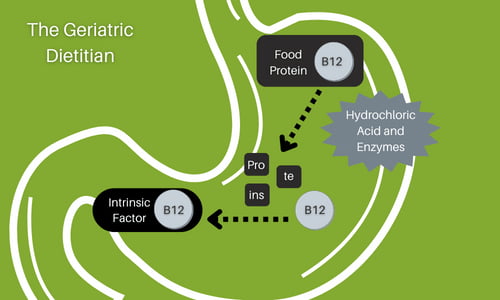Is There Vitamin B12 in Nuts and Seeds?
“Is There Vitamin B12 in Nuts and Seeds?” was written by Irene Mejía & edited/reviewed by Aly Bouzek, MS, RDN. Irene is a dietetic intern at Larkin University.
Here at The Geriatric Dietitian, we are big fans of nuts and seeds. They are small, high-calorie snacks that you can bring with you anywhere, and they also have many nutritional benefits (such as fiber, protein, and B vitamins). (1)
You may have seen some of our other articles about vitamin B12. So, let’s dive in to see if there’s vitamin B12 in nuts and seeds!
In this article you will learn the basics of vitamin B12, and how you can increase your intake of B12. More specifically, you will learn:
- About vitamin B12
- Signs and symptoms of vitamin B12 deficiency
- Importance of B12 in the elderly population
- Are nuts and seeds rich in vitamin B12?
- Top foods that are highest in vitamin B12
- Ideas on how to include these foods in your diet
Let’s get to it!
What is Vitamin B12?
Vitamin B12, also known as cobalamin, is necessary for the body to function properly. Some of its roles include: (2)
- Energy metabolism
- Protein synthesis
- Red blood cells formation
- DNA formation
- Brain and nerve functioning
In other words, this vitamin is necessary for most cells in your body. Therefore, deficiencies of vitamin B12 can be extremely harmful to our health.
How Does the Body Absorb Vitamin B12?
It’s important to know how the body absorbs B12. In fact, deficiencies can occur not only because we aren’t consuming enough vitamin B12, but also because our bodies may not be absorbing it correctly.
The absorption of B12 from food is a two-step process. (3)
Vitamin B12 is bound to proteins in the foods we eat, so it must be released before it can be absorbed.
First, the stomach has an acid called hydrochloric acid which helps release B12 from the proteins.
Then, vitamin B12 rebinds to another protein called intrinsic factor so that it can be absorbed further down in the small intestine.
On a side note, fortified foods and supplements contain B12 in its free form, so they may be absorbed more easily.

Vitamin B12 Deficiency
Vitamin B12 deficiency occurs when we’re either not consuming enough of this vitamin or our body is not able to absorb it properly.
Factors That Can Contribute to a Vitamin B12 Deficiency
The following factors can contribute to a vitamin B12 deficiency: (3)
- Age. Ability to absorb B12 decreases in the elderly
- Dietary patterns. Some diets are low in vitamin B12, especially a vegetarian or vegan diet
- Surgeries. Stomach or intestinal surgery (like weight loss surgery) can remove part of those organs or bypasses them, which affects the absorption of B12 and other nutrients
- Diseases/conditions. Some diseases prevent the normal functioning of the gastrointestinal tract, like celiac disease, Crohn’s disease, or gastritis
- Anemia. For instance, those who have pernicious anemia do not make enough intrinsic factor so B12 is not absorbed
- Medications. Medications that treat gastroesophageal reflux disease, peptic ulcer disease, and metformin (to control blood sugar levels)
Check our article on Top 5 Vitamin B12 Benefits for Elderly for a list of medications that can interfere with B12 absorption from food.
Vitamin B12 Deficiency Signs and Symptoms
Interestingly, the human body can store 1,000 to 2,000 times as much vitamin B12 as you would typically eat in a day. (3) Therefore, the symptoms of a deficiency can take a long time to appear.
The most common symptoms include: (3)
- Tiredness, weakness
- Pale skin
- Heart palpitations
- Loss of appetite, weight loss
- Numb or tingly hands and feet
- Balance problems
- Depression
- Dementia, confusion, poor memory
- Soreness of the mouth or tongue

Vitamin B12 and the Elderly Population
Decreased Vitamin B12 Absorption in the Elderly
The geriatric population is at higher risk of vitamin B12 deficiency.
As we mentioned earlier, when we age the absorption of vitamin B12 decreases. Over time, we produce less stomach acids (such as hydrochloric acid) which are needed to release this vitamin from the proteins in the foods we eat.
In fact, around 10-30% of adults aged 50 years old have a hard time absorbing vitamin B12 from the foods they eat. (2)
In addition, most of the elderly population takes several medications which can interfere with the absorption of this vitamin.
Recommended Vitamin B12 Intake
The amount of vitamin B12 you need each day depends on your age and if deficiency is present. The average daily recommended intake for adults is listed below: (3)
| Age | B12 Intake, mcg (micrograms) |
| Adults (+18 years old) | 2.4 |
If your blood tests show that you are deficient in B12, then speak with your physician and registered dietitian about an adjusted recommended intake based your individual test results.
Preventing Vitamin B12 Deficiency in Older Adults
The 2020-2025 Dietary Guidelines for Americans states that older adults are encouraged to include foods fortified with vitamin B12, such as breakfast cereals. (4)
In some cases, some individuals may also need to take vitamin B12 dietary supplements, which the body absorbs more easily.
Is There Vitamin B12 in Nuts and Seeds?
Now that we’ve covered the basics about B12, let’s discuss if nuts and seeds are rich in vitamin B12.
Unfortunately, the answer is no. Vitamin B12 is mostly found in animal foods like poultry, meat, fish, and dairy. But nuts and seeds have other fantastic health benefits, so you can still include them in a healthy diet!
Let’s cover some of the benefits, especially for the elderly population.

No Vitamin B12 in Nuts and Seeds, But They’re a High-Calorie Food!
One of the main concerns of the geriatric population is weight loss and malnutrition. This is because many older adults also suffer from decreased appetite or have difficulties eating enough food.
However, finding high-calorie healthy foods may be hard. Here is where nuts and seeds come into play: they are small snacks that contain plenty of calories. For example, 1 cup of almonds has 856 calories. (5)
And if that was not enough, they have many other nutrients as well!
No Vitamin B12 in Nuts and Seeds, But They’re Nutritious!
Nuts and seeds are also a source of additional nutrients, such as:
- Omega-3 fatty acids. These are a type of fat known to lower inflammation and can help improve lipid profiles
- Fiber. Fiber is a component in our food that can’t be digested by our bodies. The fiber content in nuts varies by type of nut. For example, half a cup of mixed nuts contains approximately 5.4 grams of fiber. (6)
- Vitamins and minerals. Many nuts and seeds are high in vitamin E, selenium, phosphorus, magnesium, and others!
If you want to learn more about nuts and how you can include them in your diet, check out our article on 10 High Calorie Nuts for Weight Gain.
Top Foods Highest in Vitamin B12
Now that we know that nuts and seeds are not high in vitamin B12, you may be wondering which are the best food sources. Keep reading to find out!
The Best Food Sources for Vitamin B12
As mentioned earlier, vitamin B12 is mostly found in animal foods like poultry, meat, fish, and dairy. Check this article to see our chart and infographic of the Foods Highest in Vitamin B12.
Vitamin B12 and Vegetarian Diets
Since vitamin B12 comes from animal foods, many people following vegetarian or vegan diets are at risk of being deficient.
Fortunately, there are some vegetarian food sources of vitamin B12. Check this article to find a list of the 11 Best Vitamin B12 Foods for Vegetarians.

Ideas on How to Include These Foods High in Vitamin B12 in Your Diet
In all of the resources above you will find so many food options rich in vitamin B12. You may be unsure of how to include them in your diet, how many times you should be eating them, or how much you should eat. Here are some ideas!
Regular diets:
- Eat 3 oz. of beef once a week
- Consume 1 serving of fish or seafood per week (such as 3 ounces of canned salmon)
- Include dairy in your diet daily (add a cheese slice to a sandwich, drink a cup of milk, snack on a yogurt)
- Eat poultry a few times a week (such as 3 ounces of chicken for lunch)
- Eat eggs for breakfast
- Include fortified foods, such as cereals
Vegetarian diets (can also be added to a non-vegetarian diet):
- Include eggs in your diet a few times a week. You can season them with some nutritional yeast for extra flavor and vitamin B12!
- Consume a fortified non-dairy product daily (such as a cup of plant-based milk, yogurt, or fortified cereal)
- A protein idea for lunch and/or dinner could be to sauté tempeh with shiitake mushrooms (you can add rice and vegetables for a side dish)
Conclusion
Vitamin B12 is necessary for our bodies to function properly.
Unfortunately, there are many factors that can affect its absorption, especially those in the elderly population.
The good news is that there are many food sources rich in vitamin B12. Most of the vitamin B12-rich foods come from animal sources, which means that nuts and seeds are not a good source of B12.
However, this doesn’t mean that nuts and seeds can’t be a staple in your diet! Nuts and seeds are high-calorie snacks packed with nutrients, which can be especially useful for older adults with unintended weight loss.
Did this article help you understand the basics of B12 in the body and what foods are best to include in your diet? Tell us in the comments!
Resources
1. Tiny but Mighty, Nuts and Seeds Deliver a Protein, Fiber, and Nutrient Punch with Every Bite. Harvard Health Publishing. https://www.health.harvard.edu/nutrition/quick-start-guide-to-nuts-and-seeds.
2. Vitamin B12. Harvard School of Public Health. https://www.hsph.harvard.edu/nutritionsource/vitamin-b12/#:~:text=Vitamin%20B12%20is%20needed%20to,B12%20into%20its%20free%20form.
3. Vitamin B12. National Institutes of Health. https://ods.od.nih.gov/factsheets/VitaminB12-Consumer/#:~:text=The%20body%20absorbs%20vitamin%20B12,the%20body%20absorbs%20them%20together.
4. Dietary Guidelines for Americans: 2020 – 2025. https://www.dietaryguidelines.gov/sites/default/files/2020-12/Dietary_Guidelines_for_Americans_2020-2025.pdf.
5. Almonds, Unsalted. FoodData Central. https://fdc.nal.usda.gov/fdc-app.html#/food-details/1100511/nutrients.
6. Mixed Nuts, Unroasted. FoodData Central. https://fdc.nal.usda.gov/fdc-app.html#/food-details/1100527/nutrients.
